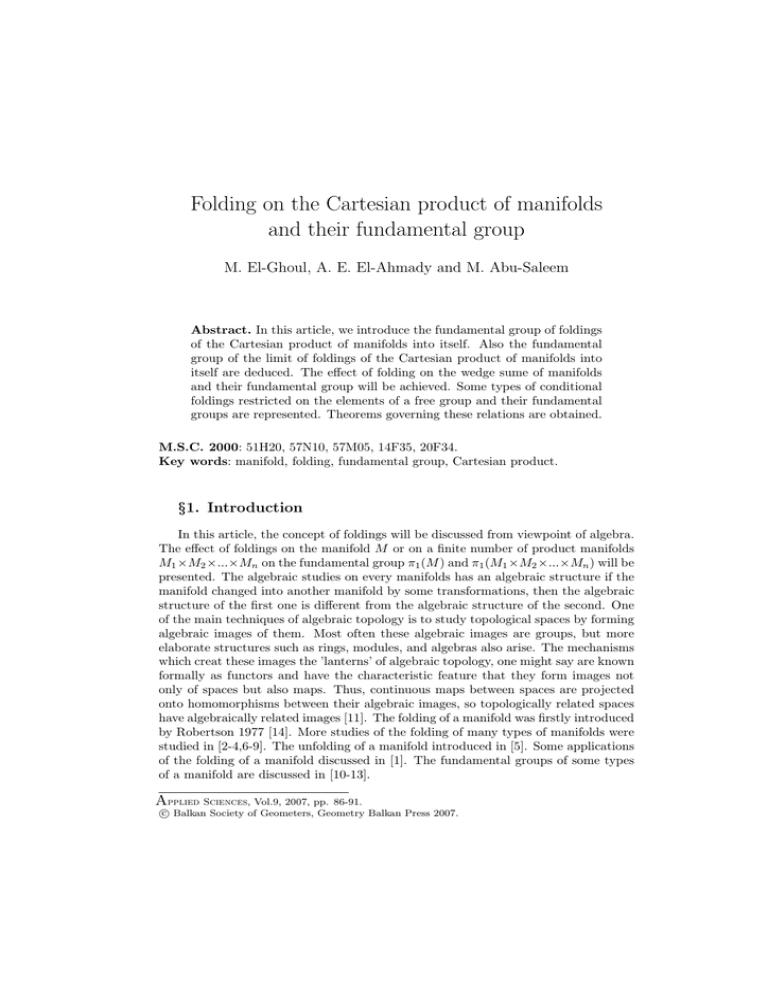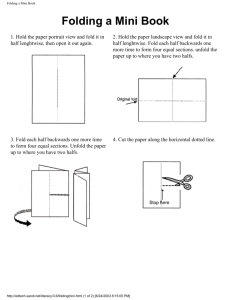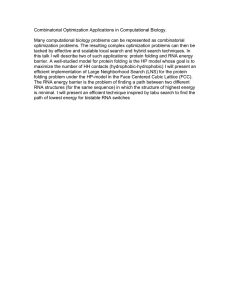Folding on the Cartesian product of manifolds and their fundamental group
advertisement

Folding on the Cartesian product of manifolds
and their fundamental group
M. El-Ghoul, A. E. El-Ahmady and M. Abu-Saleem
Abstract. In this article, we introduce the fundamental group of foldings
of the Cartesian product of manifolds into itself. Also the fundamental
group of the limit of foldings of the Cartesian product of manifolds into
itself are deduced. The effect of folding on the wedge sume of manifolds
and their fundamental group will be achieved. Some types of conditional
foldings restricted on the elements of a free group and their fundamental
groups are represented. Theorems governing these relations are obtained.
M.S.C. 2000: 51H20, 57N10, 57M05, 14F35, 20F34.
Key words: manifold, folding, fundamental group, Cartesian product.
§1. Introduction
In this article, the concept of foldings will be discussed from viewpoint of algebra.
The effect of foldings on the manifold M or on a finite number of product manifolds
M1 ×M2 ×...×Mn on the fundamental group π1 (M ) and π1 (M1 ×M2 ×...×Mn ) will be
presented. The algebraic studies on every manifolds has an algebraic structure if the
manifold changed into another manifold by some transformations, then the algebraic
structure of the first one is different from the algebraic structure of the second. One
of the main techniques of algebraic topology is to study topological spaces by forming
algebraic images of them. Most often these algebraic images are groups, but more
elaborate structures such as rings, modules, and algebras also arise. The mechanisms
which creat these images the ’lanterns’ of algebraic topology, one might say are known
formally as functors and have the characteristic feature that they form images not
only of spaces but also maps. Thus, continuous maps between spaces are projected
onto homomorphisms between their algebraic images, so topologically related spaces
have algebraically related images [11]. The folding of a manifold was firstly introduced
by Robertson 1977 [14]. More studies of the folding of many types of manifolds were
studied in [2-4,6-9]. The unfolding of a manifold introduced in [5]. Some applications
of the folding of a manifold discussed in [1]. The fundamental groups of some types
of a manifold are discussed in [10-13].
Applied Sciences, Vol.9, 2007, pp.
86-91.
c Balkan Society of Geometers, Geometry Balkan Press 2007.
°
Folding on the Cartesian product of manifolds
87
§2. Definitions
1. The set of homotopy classes of loops based at the point x0 with the product operation [f ][g] = [f.g] is called the fundamental group and denoted by π1 (X, x0 )
[11].
2. Let M and N be two manifolds of dimensions m and n respectively. A map
f : M → N is said to be an isometric folding of M into N if for every piecewise
geodesic path γ : I → M , the induced path f ◦ γ : I → N is piecewise geodesic
and of the same length as γ [14]. If f does not preserve length, it is called a
topological folding [9].
3. Let M and N be two manifolds of the same dimension. A map g : M → N is
said to be unfolding of M into N if, for every piecewise geodesic path γ : I → M,
the induced path g ◦ γ : I → N is piecewise geodesic with length greater than γ
[5].
4. Given spaces X and Y with chosen points x0 ∈ X and y0 ∈ Y , then the wedge
sum X ∨ Y is the quotient of the disjoint union X ∪ Y obtained by identifying
x0 and y0 to a single point [11].
§3. The main results
Theorem 1. If M1 , M2 , ..., Mn are path connected manifolds and F is a folding from
n
n
∨ Mi into itself then there is an induced folding F of ∗ π1 (Mi ) into itself which
i=1
i=1
n
reduce the degree of ∗ π1 (Mi ).
i=1
n
n
n
i=1
n
i=1
n
i=1
Proof. Let F : ∨ Mi → ∨ Mi be folding on ∨ Mi into itsself.
Then F : ∨ Mi → ∨ Mi has the following forms.
n
i=1
i=1
If F ( ∨ Mi ) = M1 ∨ M2 ∨ ... ∨ F (Ms ) ∨ ... ∨ Mn for s = 1, 2, ..., n, then
n
i=1
n
F ( ∗ π1 (Mi )) = π1 (F ( ∨ Mi )) ≈ π1 (M1 ) ∗ π1 (M2 ) ∗ ... ∗ π1 (F (Ms )) ∗ ... ∗ π1 (Mn ).
i=1
i=1
Since deg ree(π1 (F (Ms ))) ≤ deg ree(π1 (Ms )) it follows that F reduce the degree of
n
∗ π1 (Mi ).
i=1
n
Also, if F ( ∨ Mi ) = M1 ∨ M2 ∨ .. ∨ F (Ms ) ∨ ... ∨ F (Mk ) ∨ ... ∨ Mn for k = 1, 2, ..., n,
i=1
n
n
s < k then F ( ∗ π1 (Mi )) = π1 (F ( ∨ Mi )) ≈ π1 (M1 ) ∗ π1 (M2 ) ∗ ... ∗ π1 (F (Ms )) ∗
i=1
i=1
n
... ∗ π1 (F (Mk )) ∗ ... ∗ π1 (Mn ) and so F reduce the degree of ∗ π1 (Mi ). Moreover, by
n
i=1
n
continuing this process if F ( ∨ Mi ) = ∨ F (Mi ).
n
i=1
n
i=1
n
n
i=1
i=1
Then F ( ∗ π1 (Mi )) = π1 (F ( ∨ Mi )) = π1 ( ∨ F (Mi )) ≈ ∗ π1 (F (Mi )).
i=1
i=1
n
Hence F reduce the degree of ∗ π1 (Mi ).
i=1
88
M. El-Ghoul, A. E. El-Ahmady and M. Abu-Saleem
n
Theorem 2. For every k ≤ n,there is a folding Fk of ∨ Si1 into itself which induces
i=1
n
n
i=1
i=1
a folding Fk of ∗ π1 (Si1 ) into itself such that Fk ( ∗ π1 (Si1 )) is a free group of rank
n − k.
n
n
i=1
i=1
Proof. Let F1 : ∨ Si1 → ∨ Si1 be a folding such that
S11 ∨ S21 ∨ ... ∨ F1 (St1 ) ∨ ... ∨ Sn1 for t = 1, 2, ..., n and F1 (St1 ) 6= St1 folding with singun
n
larity as in Figure 1, then there is an induced folding F1 : ∗ π1 (Si1 ) → ∗ π1 (Si1 )
n
n
n
i=1
i=1
i=1
i=1
i=1
such that F1 ( ∗ π1 (Si1 )) = π1 (F1 ( ∨ Si1 )) and so F1 ( ∗ π1 (Si1 )) ≈ π1 (S11 ) ∗ π1 (S21 ) ∗
... ∗ π1 (F1 (St1 )) ∗ ... ∗ π1 (Sn1 ). Since π1 (F1 (St1 )) = 0 and π1 (Si1 ) ≈ Z, it follows
n
n
n
i=1
i=1
that F1 ( ∗ π1 (Si1 )) is a free group of rank n − 1. Also, let F2 : ∨ Si1 → ∨ Si1
i=1
n
be a folding such that F2 ( ∨ Si1 ) = S11 ∨ S21 ∨ ... ∨ F2 (Ss1 ) ∨ ... ∨ F2 (St1 )... ∨ Sn1 for
i=1
s, t = 1, 2, ..., n, s < t and F2 (Ss1 ) 6= Ss1 , F2 (St1 ) 6= St1 then we can get the induced
n
n
n
folding F2 : ∗ π1 (Si1 ) → ∗ π1 (Si1 ) such that F2 ( ∗ π1 (Si1 )) is a free group of rank
i=1
i=1
i=1
n − 2.
n
n
By continuing this process we obtain the folding Fn : ∨ Si1 → ∨ Si1 such that
i=1
n
1
1
1
1
Fn ( ∨ Si ) = ∨ Fn (Si ) and Fn (Si ) 6= Si which induces a folding
i=1
i=1
n
n
1
∗ π1 (Si ) such that Fn ( ∗ π1 (Si1 )) is a free group of rank 0.
i=1
i=1
n
i=1
n
Fn : ∗ π1 (Si1 ) →
i=1
Theorem 3. Let Dn , n ≥ 2 be the disjoint union of n discs on the sphere S 2 and
{Fm , m ∈ N } be a sequence of conditional folding from S 2 −Dn into itself then there is
an induced folding F m : π1 (S 2 − Dn ) = π1 (S 2 − Dn ) which depends on the conditional
folding Fm such that π1 ( lim (Fm (S 2 − Dn )) is a free group of rank n − 2.
m→∞
Proof. Let Dn , n ≥ 2 be the disjoint union of n discs on the sphere S 2 then we
can define a squence of foldings Fm : S 2 − Dn → S 2 − Dn , m = 1, 2, ... such that
lim (Fm (S 2 − Dn ) = (S 2 − Dh ) ∨ (S 2 − Dk ) where k + h = n as in Figure 2 thus
m→∞
π1 ( lim (Fm (S 2 − Dn )) = π1 (S 2 − Dh ) ∗ π1 (S 2 − Dk ) and so
m→∞
π1 ( lim (Fm (S 2 − Dn )) ≈ |Z ∗ Z {z
∗ ... ∗ Z} ∗ Z
∗ ... ∗ Z}.
| ∗ Z {z
m→∞
h−1
k−1
Hence, π1 ( lim (Fm (S 2 − Dn )) ≈ Z
∗ ... ∗ Z}.
| ∗ Z {z
m→∞
h+k−1
Therefore, π1 ( lim (Fm (S 2 − Dn )) is a free group of rank n − 2.
m→∞
Folding on the Cartesian product of manifolds
89
Theorem 4. If M1 , M2 , ..., Mn are path connected manifolds and F is a folding from
n
n
Π Mi into itself then there is an induced folding F of π1 ( Π Mi ) into itself such that
i=1
i=1
n
F (π1 ( Π Mi )) ≈ π1 (M1 ) × π1 (M2 ) × ... × π1 (F (Ms )) × ... × π1 (Mn ) for s = 1, 2, ..., n
i=1
or ≈ π1 (M1 ) × π1 (M2 ) × ... × π1 (F (Ms )) × ... × π1 (F (Mk )) × ... × π1 (Mn ) for s, k =
n
1, 2, ..., n, s < k, ..., or ≈ π1 ( Π F (Mi )).
i=1
n
n
n
i=1
i=1
Proof. Let F : Π Mi → Π Mi be folding from Π Mi into itself, then F is continuous
i=1
n
map. So we have the coordinate system of Π Mi will be on the form {(Uα1 × Uα2 ×
i=1
... × Uαn ), (Xα1 × Xα2 × ... × Xαn )}, where Xαi is injective and bicontinous mapping
from an open subset form Uαi ⊆ Rni → Mi for i = 1, 2, ..., n and {(Uαi , Xαi )} is
n
n
i=1
i=1
the atlas of Mi for i = 1, 2, ..., n then F : Π Mi → Π Mi has the following forms:
n
If F ( Π Mi ) = F (Uα1 × Uα2 × ... × Uαn , Xα1 × Xα2 × ... × Xαn ) = (Uα1 × Uα2 ×
i=1
... × Uαn , F (Uαs , Xαs ), Xα1 × Xα2 × ... × Xαn ) = M1 × M2 × ... × F (Ms ) × ... × Mn
n
n
for s = 1, 2, ..., n, then F (π1 ( Π Mi )) = π1 (F ( Π Mi )) ≈ π1 (M1 ) × π1 (M2 ) × ... ×
i=1
i=1
n
π1 (F (Ms )) × ... × π1 (Mn ). Also, if F ( Π Mi ) = F (Uα1 × Uα2 × ... × Uαn , Xα1 × Xα2 ×
i=1
... × Xαn ) = (Uα1 × Uα2 × ... × Uαn , F (Uαs , Xαs ), F (Uαk , Xαk ), Xα1 × Xα2 × ... ×
Xαn ) = M1 × M2 × ... × F (Ms ) × F (Mk ) × ... × Mn for s, k = 1, 2, ..., n, s < k, then
n
n
i=1
i=1
F (π1 ( Π Mi )) = π1 (F ( Π Mi )) ≈ π1 (M1 ) × π1 (M2 ) × ... × π1 (F (Ms )) × π1 (F (Mk )) ×
n
... × π1 (Mn ). Moreover, by continuing this process if F ( Π Mi ) = F (Uα1 × Uα2 ×
i=1
... × Uαn , Xα1 × Xα2 × ... × Xαn ) = (F (Uα1 , Xα1 ), F (Uα2 , Xα2 ), ..., F (Uαn , Xαn )) =
F (M1 ) × F (M2 ) × ... × F (Mn ), then,
n
n
n
i=1
i=1
i=1
F (π1 ( Π Mi )) = π1 (F ( Π Mi )) ≈ π1 (F (M1 )) × ... × π1 (F (Mn )) = π1 ( Π F (Mi )).
Theorem 5. If M1 , M2 , ..., Mn are path connected manifolds and F is a folding such
n
n
n
n
i=1
i=1
that F ( Π Mi ) 6= Π F (Mi ) then π1 ( lim (Fm ( Π Mi )) 6= Π (π1 ( lim (Fm (Mi ))).
i=1
m→∞
i=1
m→∞
Proof. Let T 1 be a torus. Take M1 = S 1 , M2 = S 1 , then S 1 × S 1 = T 1 , since
lim (Fm (S 1 ) =a point as in Figure 3, then lim (Fm (S 1 ) × lim (Fm (S 1 ) = point
m→∞
m→∞
and so π1 ( lim (Fm (S 1 ) × lim (Fm (S 1 )) = 0.
m→∞
m→∞
m→∞
90
M. El-Ghoul, A. E. El-Ahmady and M. Abu-Saleem
Also, it follows from F (S 1 × S 1 ) 6= F (S 1 ) × F (S 1 ) that F (S 1 × S 1 ) = F (S 1 ) × S 1
or F (S 1 × S 1 ) = S 1 × F (S 1 ) thus, lim Fm (S 1 × S 1 ) = S 1 .
m→∞
So, π1 ( lim Fm (S 1 × S 1 )) = π1 (S 1 ) ≈ Z.
m→∞
Hence π1 ( lim (Fm (S 1 × S 1 )) 6= π1 ( lim (Fm (S 1 )) × π1 ( lim (Fm (S 1 )).
m→∞
m→∞
m→∞
Corollary 1. If M1 , M2 , ..., Mn are path connected manifolds and F is a folding
n
n
i=1
i=1
n
n
such that F ( Π Mi ) = Π F (Mi ) then π1 ( lim Fm ( Π Mi )) ≈ Π ( lim π1 (Fm (Mi ))).
m→∞
i=1
i=1 m→∞
References
[1] P.DI-Francesco, Folding and coloring problem in mathematics and physics, Bulletin of the American Mathematical Society 37, 3 (2000), 251-307.
[2] A.E. El-Ahmady, The deformation retract and topological folding of Buchdahi
space, Periodica Mathematica Hungarica 28, 1 (1994), 19-30.
[3] A.E. El-Ahmady, Fuzzy Lobachevskian space and its folding, The Journal of Fuzzy
Mathematics 2, 2 (2004), 255-260.
[4] A.E. El-Ahmady, Fuzzy folding of fuzzy horocycle, Circolo Mathematico Palermo,
series II, Tomo L III (2004), 443-450.
[5] M. El-Ghoul, Unfolding of Riemannian manifold, Commun. Fac. Sci. Univ.
Ankara Ser. A, 37 (1988), 1-4.
[6] M. El-Ghoul, The deformation retract of the complex projective space and its
topological folding, Journal of Material Science 30 (1995), 4145-4148.
[7] M. El-Ghoul, Fractional folding of a manifold, Chaos, Solitons and Fractals 12
(2001), 1019-1023.
[8] M. El-Ghoul, A.E. El-Ahmady, H.Rafat, Folding-retraction of chaotic dynamical
manifold and the VAK of vacuum fluctuation, Chaos, Solitons and Fractals, 20
(2004), 209-217.
[9] E. El-Kholy, Isometric and Topological Folding of Manifold, Ph.D. Thesis, University of Southampton, U.K., 1981.
Folding on the Cartesian product of manifolds
91
[10] R. Frigerio, Hyperbolic manifold with geodesic boundary which are determined by
their fundamental group, Topology and its Applications 45 (2004), 69-81.
[11] A. Hatcher, Algebraic Topology, URL http://www.math.coronell.edu/hatcher.
[12] W.S. Massey, Algebraic Topology, an Introduction, Harcourt, Brace & World,
Inc., New York 1967.
[13] O. Neto and P.C. Silva, The fundamental group of an algebraic link, C.R. Acad.
Sci. Paris, Ser. I, 340 (2005), 141-146.
[14] S. A. Robertson, Isometric folding of Riemannian manifolds, Proc. Roy. Soc.
Edinburgh, 77 (1977), 275-289.
Authors’ addresses:
M. El-Ghoul, A. E. El-Ahmady and M. Abu-Saleem
Mathematics Department, Faculty of Science, Tanta University, Tanta, Egypt.
e-mail: m elghoul2006@yahoo.com, mohammedabusaleem2005@yahoo.com



